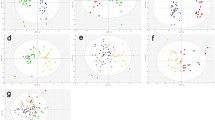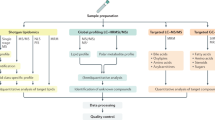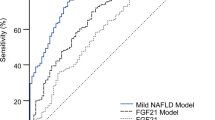Abstract
Background and Aim
Oxidative stress is a core abnormality responsible for disease progression in nonalcoholic fatty liver disease (NAFLD). By employing a highly sensitive liquid chromatography–tandem mass spectrometry (LC/MS/MS) approach we recently were able to define the circulating profile of bioactive lipid peroxidation products characteristic of patients with nonalcoholic steatohepatitis (NASH) and developed the OxNASH score for NASH diagnosis. The aims of this study were to assess the utility of OxNASH as a predictor of NASH and study the association between OxNASH and specific histologic features of NAFLD.
Methods
Our cohort consisted of 122 patients undergoing liver biopsy for clinical suspicion of NAFLD. The NAFLD activity score (NAS) was calculated for each patient. Levels of fatty acid oxidation products were quantified using stable isotope dilution LC/MS/MS, and OxNASH was calculated.
Results
The mean age of our patients was 49.3 (±11.6) years, and the mean body mass index was 31.5 (±4.8) kg/m2. The majority of patients were Caucasian (82 %) and 48 % were female. OxNASH correlated with NAS and with the individual histologic features of NAFLD, namely, steatosis, inflammation, and ballooning (P < 0.05), with the strongest association being with inflammation [rho (ρ) 0.40, 95 % confidence interval 0.23, 0.57, P < 0.001]. There was also a correlation between the stage of fibrosis and OxNASH (P = 0.001). These associations remained statistically significant after adjustment for multiple confounders.
Conclusions
Based on our results, in adult patients with NAFLD, OxNASH correlates with histologic features of NASH and appears to be a promising noninvasive marker.



Similar content being viewed by others
References
Alkhouri N, Feldstein AE. The TONIC trial: a step forward in treating pediatric nonalcoholic fatty liver disease. Hepatology (Baltimore, Md). 2012;55:1292–1295.
Ascha MS, Hanouneh IA, Lopez R, Tamimi TA, Feldstein AF, Zein NN. The incidence and risk factors of hepatocellular carcinoma in patients with nonalcoholic steatohepatitis. Hepatology (Baltimore, Md). 2010;51:1972–1978.
Baskol M, Baskol G, Deniz K, Ozbakir O, Yucesoy M. A new marker for lipid peroxidation: serum paraoxonase activity in non-alcoholic steatohepatitis. Turk J Gastroenterol. 2005;16:119–123.
Bhattacharyya T, Nicholls SJ, Topol EJ, et al. Relationship of paraoxonase 1 (PON1) gene polymorphisms and functional activity with systemic oxidative stress and cardiovascular risk. JAMA. 2008;299:1265–1276.
Browning JD, Szczepaniak LS, Dobbins R, et al. Prevalence of hepatic steatosis in an urban population in the United States: impact of ethnicity. Hepatology (Baltimore, Md). 2004;40:1387–1395.
Brunt EM. Pathology of nonalcoholic steatohepatitis. Hepatol Res. 2005;33:68–71.
Brunt EM, Janney CG, Di Bisceglie AM, Neuschwander-Tetri BA, Bacon BR. Nonalcoholic steatohepatitis: a proposal for grading and staging the histological lesions. Am J Gastroenterol. 1999;94:2467–2474.
Chalasani N, Deeg MA, Crabb DW. Systemic levels of lipid peroxidation and its metabolic and dietary correlates in patients with nonalcoholic steatohepatitis. Am J Gastroenterol. 2004;99:1497–1502.
Edmison J, McCullough AJ. Pathogenesis of non-alcoholic steatohepatitis: human data. Clin Liver Dis. 2007;11:75–104.
Feldstein AE, Lopez R, Tamimi TA, et al. Mass spectrometric profiling of oxidized lipid products in human nonalcoholic fatty liver disease and nonalcoholic steatohepatitis. J Lipid Res. 2010;51:3046–3054.
George J, Pera N, Phung N, Leclercq I, Yun Hou J, Farrell G. Lipid peroxidation, stellate cell activation and hepatic fibrogenesis in a rat model of chronic steatohepatitis. J Hepatol. 2003;39:756–764.
Kleiner DE, Brunt EM, Van Natta M, et al. Design and validation of a histological scoring system for nonalcoholic fatty liver disease. Hepatology (Baltimore, Md). 2005;41:1313–1321.
Lavine JE, Schwimmer JB, Van Natta ML, et al. Effect of vitamin E or metformin for treatment of nonalcoholic fatty liver disease in children and adolescents: the TONIC randomized controlled trial. JAMA. 2011;305:1659–1668.
Matteoni CA, Younossi ZM, Gramlich T, Boparai N, Liu YC, McCullough AJ. Nonalcoholic fatty liver disease: a spectrum of clinical and pathological severity. Gastroenterology. 1999;116:1413–1419.
Miller MH, Ferguson MA, Dillon JF. Systematic review of performance of non-invasive biomarkers in the evaluation of non-alcoholic fatty liver disease. Liver Int. 2011;31:461–473.
Oliveira CP, da Costa Gayotto LC, Tatai C, et al. Oxidative stress in the pathogenesis of nonalcoholic fatty liver disease, in rats fed with a choline-deficient diet. J Cell Mol Med. 2002;6:399–406.
Rockey DC, Caldwell SH, Goodman ZD, Nelson RC, Smith AD. Liver biopsy. Hepatology (Baltimore, Md). 2009;49:1017–1044.
Sanyal AJ, Brunt EM, Kleiner DE, et al. Endpoints and clinical trial design for nonalcoholic steatohepatitis. Hepatology (Baltimore, Md). 2011;54:344–353.
Sanyal AJ, Campbell-Sargent C, Mirshahi F, et al. Nonalcoholic steatohepatitis: association of insulin resistance and mitochondrial abnormalities. Gastroenterology. 2001;120:1183–1192.
Sanyal AJ, Chalasani N, Kowdley KV, et al. Pioglitazone, vitamin E, or placebo for nonalcoholic steatohepatitis. N Engl J Med. 2010;362:1675–1685.
Schwimmer JB, Deutsch R, Kahen T, Lavine JE, Stanley C, Behling C. Prevalence of fatty liver in children and adolescents. Pediatrics. 2006;118:1388–1393.
Videla LA, Rodrigo R, Araya J, Poniachik J. Oxidative stress and depletion of hepatic long-chain polyunsaturated fatty acids may contribute to nonalcoholic fatty liver disease. Free Radic Biol Med. 2004;37:1499–1507.
Zein CO, Lopez R, Kirwan JP, et al. Pentoxifylline decreases oxidized lipid products in nonalcoholic steatohepatitis: new evidence on the potential therapeutic mechanism. Hepatology. 2012;56:1291–1299.
Zhang R, Shen Z, Nauseef WM, Hazen SL. Defects in leukocyte-mediated initiation of lipid peroxidation in plasma as studied in myeloperoxidase-deficient subjects: systematic identification of multiple endogenous diffusible substrates for myeloperoxidase in plasma. Blood. 2002;99:1802–1810.
Acknowledgments
This work was supported by National Institutes of Health Grants P01 HL076491, 1P20HL113452, P01HL098055, DK076852, AA017748, and P01 HL087018-020001, Stanley L. Hazen is also supported by a gift from the Leonard Krieger Fund. Studies were supported by National Institutes of Health Grants P01 HL076491 and P20HL113452-01. Stanley L. Hazen reports partial support from a gift from the Krieger Foundation. Mass Spectrometry studies were performed on instrumentation housed in the Cleveland Clinic Mass Spectrometry facility, which is partially supported by a Center of Innovation Award by ABI SCIEX.
Conflict of interest
Dr. Hazen is listed as co-inventor on pending and issued patents held by the Cleveland Clinic relating to diagnostics. He has received payments as a consultant or speaker for Abbott, Cleveland Heart Lab, Esperion, Lilly, Liposcience Inc., Merck & Co., Inc., and Pfizer Inc. and received research funds from Abbott, Cleveland Heart Lab, Liposcience Inc., and Pfizer Inc. Dr. Hazen reports having the right to receive royalty payments for inventions or discoveries related to diagnostics or therapeutics from the companies. All of the other authors report no conflict of interest.
Author information
Authors and Affiliations
Corresponding author
Additional information
Stanley L. Hazen and Ariel E. Feldstein are senior authors for this article.
Rights and permissions
About this article
Cite this article
Alkhouri, N., Berk, M., Yerian, L. et al. OxNASH Score Correlates with Histologic Features and Severity of Nonalcoholic Fatty Liver Disease. Dig Dis Sci 59, 1617–1624 (2014). https://doi.org/10.1007/s10620-014-3031-8
Received:
Accepted:
Published:
Issue Date:
DOI: https://doi.org/10.1007/s10620-014-3031-8




